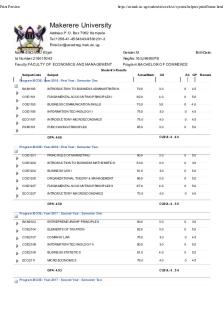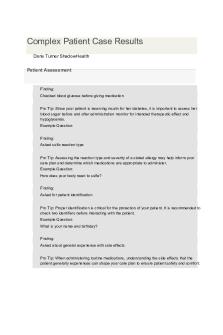Results section PDF

| Title | Results section |
|---|---|
| Course | Introductory Biology I |
| Institution | Kwantlen Polytechnic University |
| Pages | 3 |
| File Size | 97.7 KB |
| File Type | |
| Total Downloads | 81 |
| Total Views | 137 |
Summary
Lab report ...
Description
Results. In treatment group 1, the blackworms were exposed to a high concentration of nicotine at 1.0mM for 60 seconds in a petri dish. In the second treatment group the blackworms were exposed to 1.0mM of caffeine for 60 seconds in a petri dish. Resulting in a mean pulse rate of 17.7bpm 0.79 in treatment group 1. In comparison treatment group 2 the mean pulse rate was 12.2bpm 0.99 which was a decrease. The control group had a mean of 11.6bpm 0.79 which was below both the treatment groups mean as shown in Figure 1. The 95% confidence intervals are shown in the graph below in figure 1. 20 19
Mean Pulse Rates (bpm)
18 17 16 15 14 13 12 11 10 Control Group (distilled water)
Treatment 1 (nicotine 1mM)
Treatment 2 (caffeine 1mM)
Experiment Groups
Figure 1. Mean pulse rate (bpm) of Lumbriculus variegatus (blackworms) when exposed to caffeine1mM concentration, nicotine 1mM concentration and distilled water for 60 seconds. Bars on graph indicate the 95% confidence intervals of the sample means.
Discussion. As shown in figure 1, there is an overlap between control group, exposed to distilled water and treatment group 2 exposed to caffeine 1mM. Therefore, we fail to reject our null hypothesis. The exposure of caffeine 1mM will not have an effect on the pulse rate (bpm) of the Lumbriculus variegatus (blackworms). However, there is no overlap between control group, exposed to distilled water and treatment group 2, exposed to nicotine 1mM. Therefore, we reject our null hypothesis. The exposure of nicotine 1mM will have an effect on the pulse rate (bpm) of the Lumbriculus variegatus (blackworms).
A source of error in this experiment is biological variation of the blackworms. This kind of error is a random error. The blackworms could have had variance in their surrounding environments, ages, size or had some issues with their pulse rate to begin with. Having differences in environment could mean the blackworms had different diets and temperatures. Having a different diet would have caused a difference in how they metabolize certain things such as the nicotine and caffeine. A way to improve the experiment would be to find blackworms from the same place and using ones with similar size. As well as measuring their control pulse rates to see if there is a significant variance before beginning the experiment.
In future experiments, we would like to measure their mean pulse rate after a significant amount of time after the exposure to the nicotine and caffeine concentrations has been made. Doing a follow up to see how the blackworms have reacted to the chemical concentrations. This number calculated after the exposure to nicotine and caffeine can then be compared to the
numbers measured in this experiment immedicably after the initial exposure. We can study the long-term effects these chemicals have on this specific kind of worms and compare it to the control groups to see if there are any long-term effects....
Similar Free PDFs

Results section
- 3 Pages

How to write a results section
- 4 Pages

Results
- 3 Pages

Provisional Results
- 2 Pages

Eli Results
- 6 Pages

2Complex Patient Case Results
- 6 Pages

My Strength Quest Results
- 2 Pages

Measurement lab results
- 12 Pages

My Plate-Quiz-Results
- 2 Pages

CASHLESS PAYMENT RESULTS SPSS
- 44 Pages

Student results management system
- 12 Pages

Pediatric Lab results
- 4 Pages

Results for strengthsquest
- 2 Pages
Popular Institutions
- Tinajero National High School - Annex
- Politeknik Caltex Riau
- Yokohama City University
- SGT University
- University of Al-Qadisiyah
- Divine Word College of Vigan
- Techniek College Rotterdam
- Universidade de Santiago
- Universiti Teknologi MARA Cawangan Johor Kampus Pasir Gudang
- Poltekkes Kemenkes Yogyakarta
- Baguio City National High School
- Colegio san marcos
- preparatoria uno
- Centro de Bachillerato Tecnológico Industrial y de Servicios No. 107
- Dalian Maritime University
- Quang Trung Secondary School
- Colegio Tecnológico en Informática
- Corporación Regional de Educación Superior
- Grupo CEDVA
- Dar Al Uloom University
- Centro de Estudios Preuniversitarios de la Universidad Nacional de Ingeniería
- 上智大学
- Aakash International School, Nuna Majara
- San Felipe Neri Catholic School
- Kang Chiao International School - New Taipei City
- Misamis Occidental National High School
- Institución Educativa Escuela Normal Juan Ladrilleros
- Kolehiyo ng Pantukan
- Batanes State College
- Instituto Continental
- Sekolah Menengah Kejuruan Kesehatan Kaltara (Tarakan)
- Colegio de La Inmaculada Concepcion - Cebu


